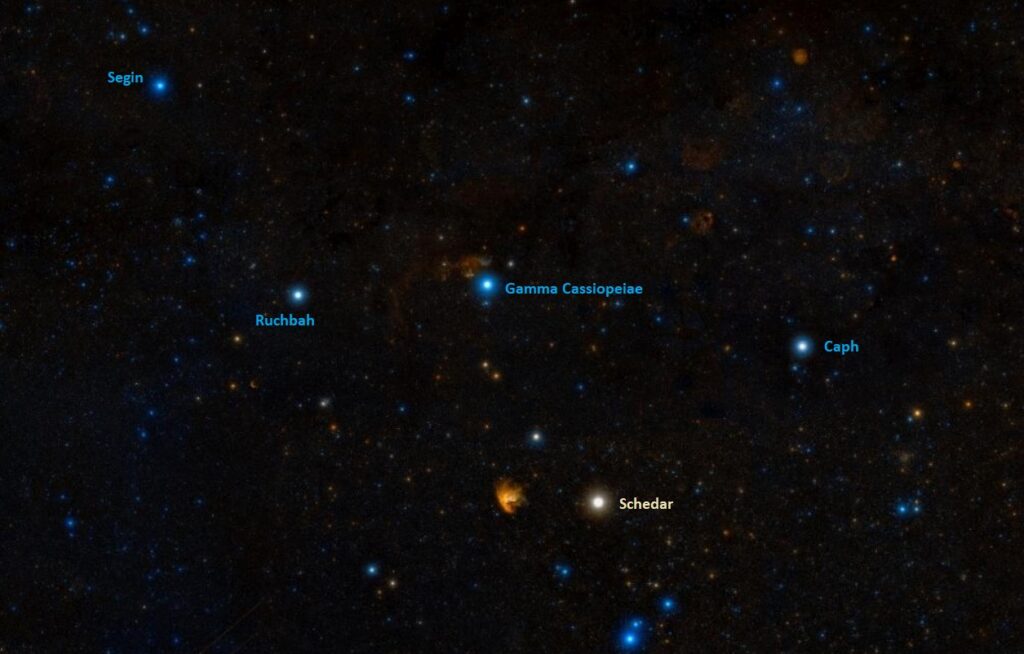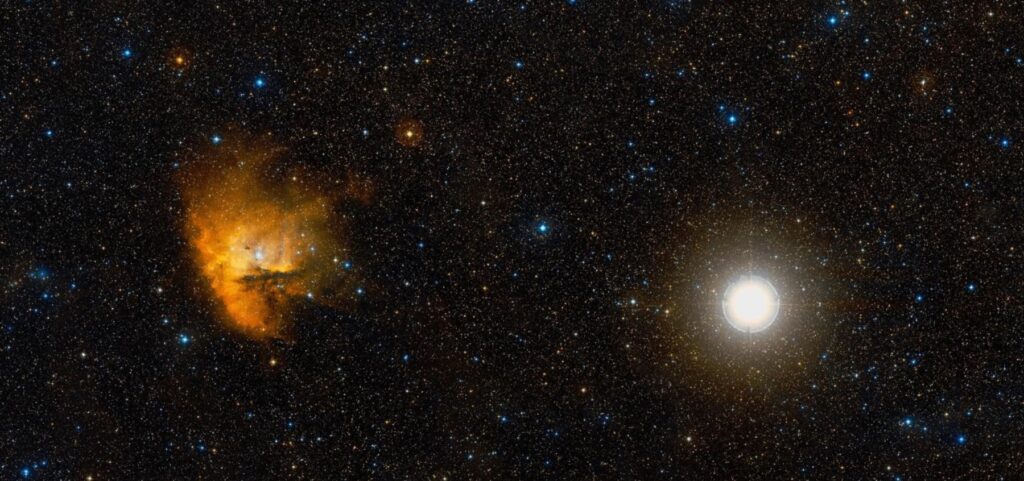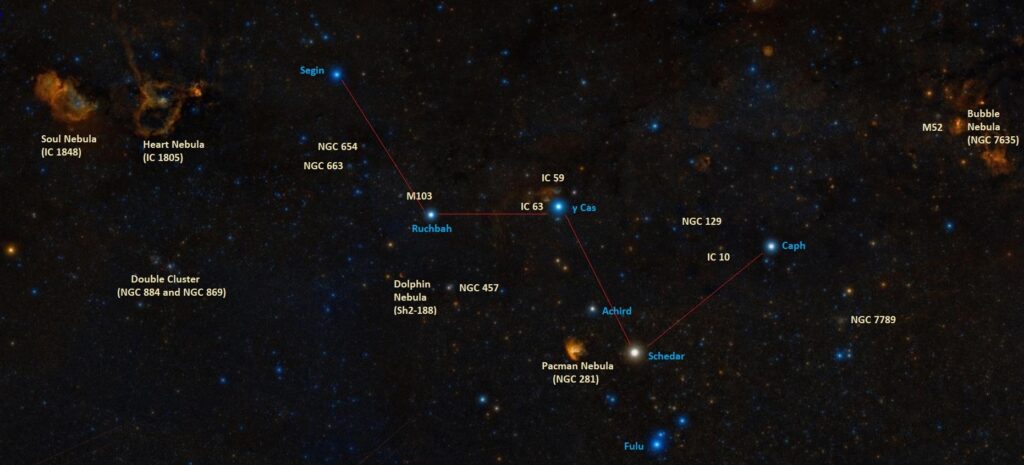Schedar, Alpha Cassiopeiae (α Cas) is an orange giant star located in the constellation Cassiopeia. It lies at a distance of 228 light years from Earth. With an apparent magnitude of 2.240, it is the brightest or second brightest star in Cassiopeia. It is sometimes outshined by its variable neighbour Gamma Cassiopeiae (mag. 1.6 – 3.0) and it just barely outshines Caph (Beta Cassiopeiae, mag. 2.28). All three stars are part of Cassiopeia’s familiar W asterism.
Star type
Schedar has the stellar classification K0IIIa, indicating a giant star appearing orange in colour. The star is 4-5 times more massive than the Sun and has a radius about 42.1 times solar. With a surface temperature of 4,530 K, it shines with 676 solar luminosities. The star’s estimated age is between 100 and 200 million years.
Schedar is a relatively slow spinner. With a projected rotational velocity of 21 km/s, it takes about 102 days to complete a rotation.
Schedar’s angular diameter was measured in 1998, yielding a value of 5.62 ± 0.06 milliarcseconds for the limb-darkened diameter. This translates into a physical radius of 0.393 astronomical units, or about 42 solar radii.
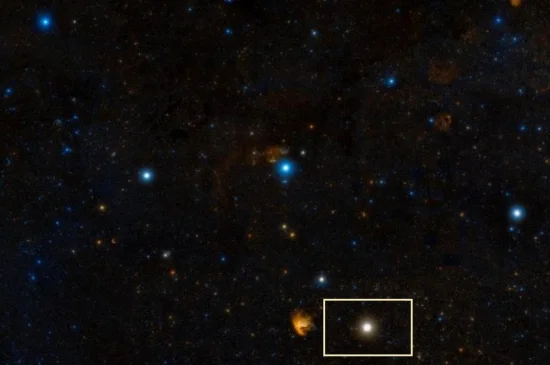
Schedar (Alpha Cassiopeiae), image: Wikisky
Schedar was reported to be a variable star in the 19th century and is still often listed as a suspected variable. However, no evidence of variability has been detected in the past century.
Facts
Schedar is one of the 58 bright stars selected for use in navigation. It is the only navigational star in Cassiopeia. Navigational stars have a special status in the field of celestial navigation because they are bright and easy to identify. As part of Cassiopeia’s W, Schedar is one of the easiest stars to find. It is one of the 11 northern navigational stars with a declination between 30° N and 90° N. Other stars in this group are Capella in the constellation Auriga, Vega in Lyra, Deneb in Cygnus, Mirfak in Perseus, Alioth, Dubhe and Alkaid in Ursa Major, Polaris and Kochab in Ursa Minor, and Eltanin in Draco.
Schedar forms Cassiopeia’s prominent W pattern with Caph (Beta Cassiopeiae), Gamma Cassiopeiae, Ruchbah (Delta Cassiopeiae), and Segin (Epsilon Cassiopeiae). From locations south of the equator, the W appears inverted (if it rises at all). It also appears inverted when seen from the northern hemisphere during the winter months.
On average, Schedar is the 71st brightest star in the sky. It is about as bright as Alphecca in the constellation Corona Borealis, Suhail in Vela, Sadr in Cygnus, Eltanin in Draco, and Mintaka in Orion. It just outshines its neighbour Caph in Cassiopeia, Epsilon Centauri in Centaurus, and Dschubba in Scorpius.
Even though the German astronomer Johann Bayer assigned it the designation Alpha, Schedar appears as bright as Caph, Beta Cassiopeiae. Each of the two stars can appear brighter or fainter than the other in different passbands. To the unaided eye, they appear equally bright. Schedar was confirmed to be marginally brighter than Caph by observations and measurements made with NASA’s WISE telescope. Schedar is almost 25 times more intrinsically luminous than Caph, with an energy output 676 times that of the Sun (compared to Caph’s luminosity of 27.3 L☉) and it is about four times more distant than Caph, which lies 54.7 light years away.
Schedar is the coolest and largest of the five stars that form Cassiopeia’s W. With a size of 42.1 solar radii, it is more than four times larger than the second largest star, Gamma Cassiopeiae (10 R☉), and more than 10 times larger than Caph (3.43 – 3.69 R☉) and Ruchbah (3.90 R☉). However, with a mass of 4-5 solar masses, it is only the third most massive of the five stars. The blue, class B stars Gamma Cassiopeiae and Segin (Epsilon Cassiopeiae) are both more massive, with 17 and 9.2 solar masses respectively.
Name
The name Schedar (pronunciation: /ˈʃɛdɑːr/) comes from the Arabic şadr, meaning “breast.” It refers to the star’s position in the constellation Cassiopeia, marking the mythical queen’s heart. The name of Gamma Cygni, Sadr, is derived from the same word. Sadr marks the chest of the celestial Swan (Cygnus).
The name Schedar was officially approved by the International Astronomical Union’s (IAU) Working Group on Star Names (WGSN) on August 21, 2016.
The name has been spelled differently over the centuries. Variations include Schedir, Sheder, Shedar, Shedis, Shadar, Shedir, Seder, Zedaron, and Sheder.
The 10th century Persian astronomer Al-Sufi and 15th century Timurid astronomer Ulugh Beg called Alpha Cassiopeiae Al Dhāt al Kursiyy, meaning “the lady in the chair.” The 17th century Italian astronomer Giovanni Battista Riccioli changed the name to Dath Elkarti.
In Chinese astronomy, Alpha Cassiopeiae is known as 王良四 (Wáng Liáng sì), the Fourth Star of Wang Liang. The Chinese Wang Liang asterism (named after a famous charioteer during the Spring and Autumn period in China) is formed by Schedar with Caph (Beta Cassiopeiae), Kappa Cassiopeiae, Achird (Eta Cassiopeiae), and Lambda Cassiopeiae. The asterism is part of the Legs mansion, which represents the tail of the White Tiger of the West.
Location
Schedar is very easy to find because it is part of a bright, prominent asterism. It is the bottom right star of Cassiopeia’s W. It can be seen from all locations north of the latitude 33° S. Observers south of the equator can only see it low above the horizon at certain times of the year.
Schedar and other bright stars of Cassiopeia lie in a rich field of the Milky Way and can be used to find a number of bright deep sky objects. Schedar can be used to find the bright emission nebula NGC 281, popularly known as the Pacman Nebula. The nebula is also catalogued as IC 11 and Sharpless 184. With a physical radius of 48 light years, it stretches across 35’ of the sky and is associated with the open cluster IC 1590. It lies at an approximate distance of 9,500 light years.
Schedar can also be used to find several deep sky objects that do not appear in the same field of view. A line drawn from Schedar through Caph, the top right star of Cassiopeia’s W, leads to the bright open cluster Messier 52. With an apparent magnitude of 5.0, the cluster is easily seen in binoculars. It lies 4,600 light years away.
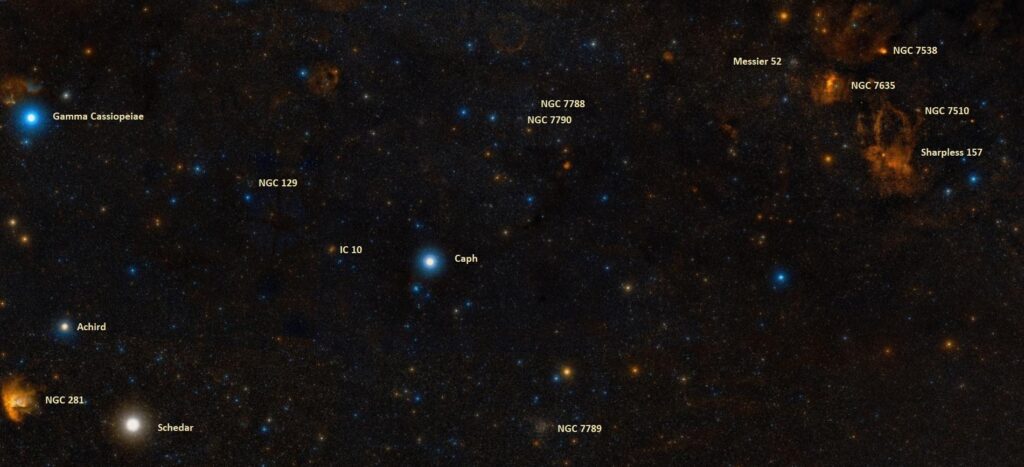
Caph, Schedar, Messier 52, NGC 7635, NGC 7538, NGC 7510, NGC 7790, NGC 7788 and NGC 7789, image: Wikisky
Several other deep sky objects lie in the vicinity of M52: the magnitude 10 emission nebula NGC 7635, better known as the Bubble Nebula, the emission nebula Sharpless 157, nicknamed the Lobster Claw Nebula, the star-forming nebula NGC 7538, and the open cluster NGC 7510. These objects lie on the border of the constellations Cassiopeia and Cepheus. M52, the Bubble Nebula and the Lobster Claw Nebula are in Cassiopeia and NGC 7538 and NGC 7510 lie in Cepheus.
Constellation
Schedar is located in the constellation Cassiopeia. Circumpolar to northern observers, Cassiopeia stretches across 598 square degrees of the northern sky between the constellation Camelopardalis (the Giraffe) and three other constellations associated with the myth of Perseus: Perseus, Andromeda and Cepheus. Representing the boastful Queen Cassiopeia, mother of Andromeda and wife of Cepheus in Greek mythology, Cassiopeia is one of the 48 Greek constellations, first listed by the Greek astronomer Ptolemy of Alexandria in his Almagest in the 2nd century CE.
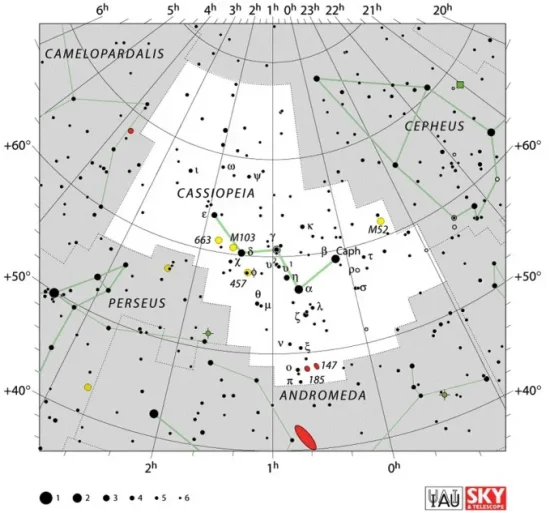
Cassiopeia constellation map by IAU and Sky&Telescope magazine
Nicknamed the “W constellation,” Cassiopeia is best known for the pattern formed by its five brightest stars, which appears as a W or an M at different times of the year. The constellation contains a number of interesting stars, including Gamma Cassiopeiae, a fast-spinning eruptive variable that serves as a prototype for its own class of variable stars, Rho Cassiopeiae, a pulsating variable yellow hypergiant, and V509 Cassiopeiae, a semiregular variable yellow hypergiant.
Cassiopeia is also home to two well-known supernova remnants: Tycho’s Nova (SN 1572), the remnant of a Type Ia supernova observed in November 1572, and Cassiopeia A, the expanding shell of a star that went out some 300 years ago. Cassiopeia A is the brightest radio source in the sky outside the solar system.
The best known deep sky objects in Cassiopeia are the neighbouring emission nebulae IC 1805 and IC 1848, also known as the Heart and Soul nebulae, the Bubble Nebula (NGC 7635), the Pacman Nebula (NGC 281) near Schedar, the Fish Head Nebula (IC 1795), the bright open clusters Messier 52, Messier 103 and the Owl Cluster (NGC 457) near Ruchbah, Caroline’s Rose Cluster (NGC 7789) near Caph, NGC 663 and NGC 654 between Segin and Ruchbah, and the irregular starburst galaxy IC 10 near Caph.
The best time of year to observe the stars and deep sky objects of Cassiopeia is during the month of November. The constellation is visible in its entirety from locations between the latitudes 90° N and 20° S.
The 10 brightest stars in Cassiopeia are Gamma Cassiopeiae (mag. 1.6 – 3.0), Schedar (Alpha Cas, mag. 2.24), Caph (Beta Cas, mag. 2.28), Ruchbah (Delta Cas, mag. 2.68), Segin (Epsilon Cas, mag. 3.37), Achird (Eta Cas, mag. 3.44), Fulu (Zeta Cas, mag. 3.66), 50 Cassiopeiae (mag. 3.95), Kappa Cassiopeiae (mag. 4.16), and Theta Cassiopeiae (mag. 4.334).
Schedar – Alpha Cassiopeiae
| Spectral class | K0IIIa |
| Variable type | Suspected |
| U-B colour index | 1.14 |
| B-V colour index | 1.16 |
| Apparent magnitude | 2.240 |
| Absolute magnitude | -1.985 |
| Distance | 228 ± 2 light years (70.0 ± 0.7 parsecs) |
| Parallax | 14.29 ± 0.15 mas |
| Radial velocity | -4.204 km/s |
| Proper motion | RA: 50.36 mas/yr |
| Dec.: -32.17 mas/yr | |
| Mass | 4-5 M☉ |
| Luminosity | 676 L☉ |
| Radius | 42.1 ± 1.7 R☉ |
| Temperature | 4,530 K |
| Metallicity | -0.1 dex |
| Age | 100 – 200 million years |
| Rotational velocity | 21 km/s |
| Constellation | Cassiopeia |
| Right ascension | 00h 40m 30.4410679s |
| Declination | +56° 32′ 14.39217″ |
| Names and designations | Schedar, Alpha Cassiopeiae, α Cas, 18 Cassiopeiae, HD 3712, HR 168, HIP 3179, SAO 21609, GC 792, GCRV 364, BD+55°139, FK5 21, PPM 25578, ADS 561, CCDM J00405+5632, IDS 00348+5559, UBV 517, IRAS 00376+5615, JP11 402, PLX 114.00, 2MASS J00403044+5632145, TYC 3663-2668-1, AAVSO 0034+55, Gaia DR2 418551920279473536, WDS J00405+5632A |
